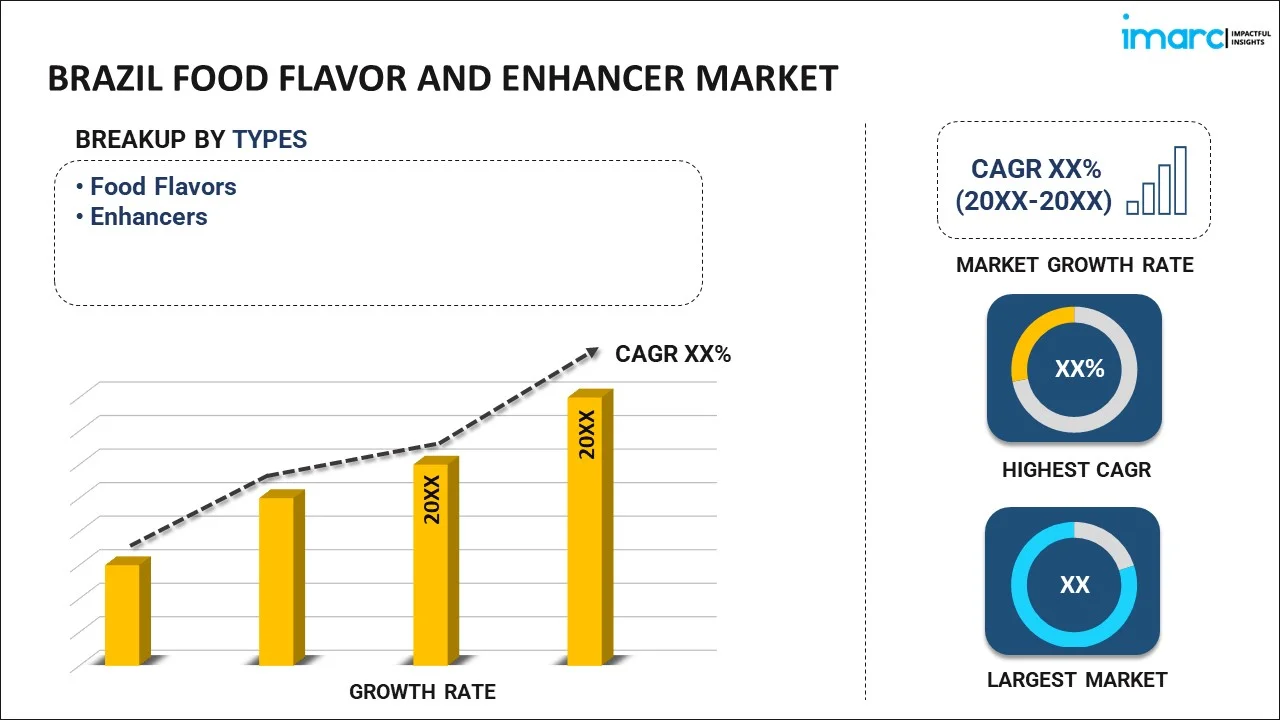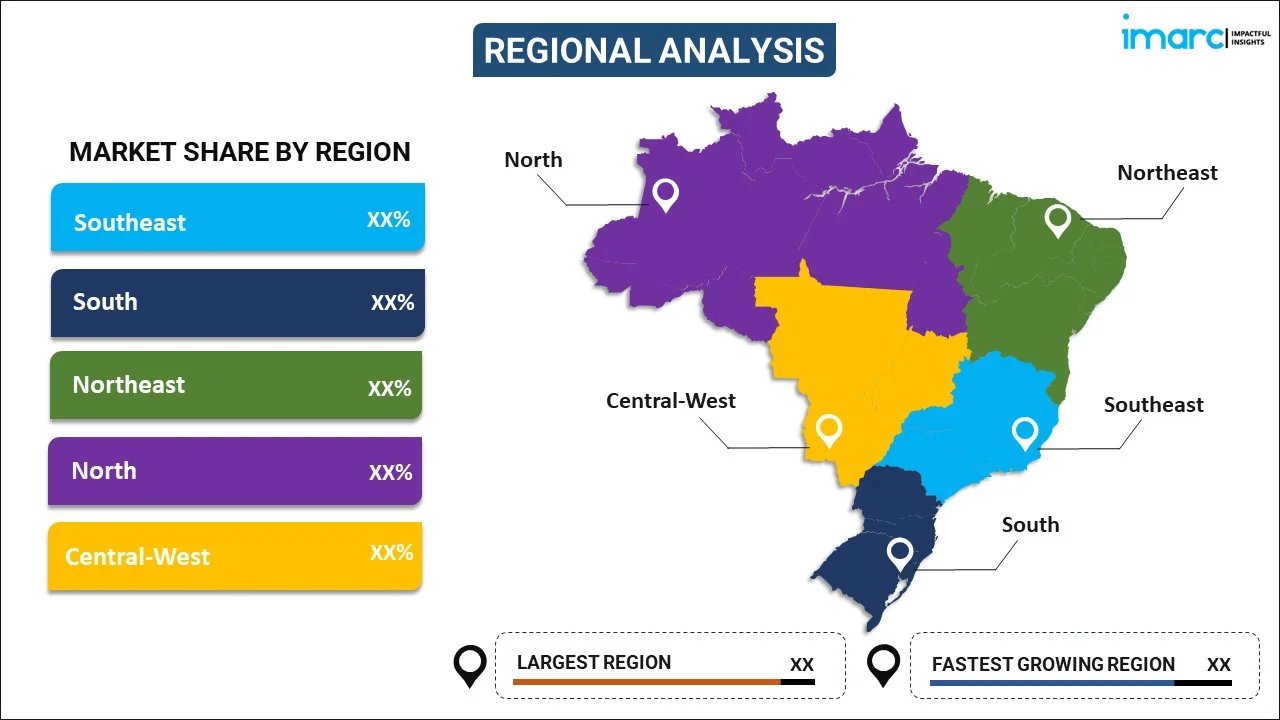
Brazil Food Flavor and Enhancer Market Report by Type (Food Flavors, Enhancers), End User (Bakery and Confectionery, Dairy, Meat and Meat Products, Soups, Pastas, and Noodles, Beverages, Sauces, Dressings, and Condiments, and Others), and Region 2025-2033
Market Overview:
Brazil food flavor and enhancer market size reached USD 342.7 Million in 2024. Looking forward, IMARC Group expects the market to reach USD 539.9 Million by 2033, exhibiting a growth rate (CAGR) of 4.6% during 2025-2033. Changing consumer preferences, growing food processing industry, rapid urbanization and busy lifestyles, increased food imports, innovations in product development, rising consumer interest in natural and clean-label products, increasing health and wellness trends, and diverse culinary traditions represent some of the key factors driving the market.
|
Report Attribute
|
Key Statistics
|
|---|---|
|
Base Year
|
2024 |
|
Forecast Years
|
2025-2033
|
|
Historical Years
|
2019-2024
|
| Market Size in 2024 | USD 342.7 Million |
| Market Forecast in 2033 | USD 539.9 Million |
| Market Growth Rate (2025-2033) | 4.6% |
Food flavor enhancers are substances added to foods to intensify or enhance their existing flavors without providing a distinct flavor of their own. They are commonly used in the food industry to improve the taste profile of various products. Flavor enhancers work by stimulating taste receptors on the tongue and enhancing the perception of the basic tastes such as sweet, salty, sour, and umami. One of the most well-known flavor enhancers is monosodium glutamate (MSG), which enhances the savory or umami taste in foods. It is widely used in savory dishes, soups, snacks, and processed foods to make them taste more savory and appealing. Food flavor enhancers are distinct from food flavorings or additives that impart a specific taste or aroma to a product. Instead, they work to intensify and improve the existing flavors in a dish. Besides MSG, other natural and artificial flavor enhancers include nucleotides like inosine monophosphate (IMP) and guanosine monophosphate (GMP), which are often used in combination with MSG to boost umami taste. These enhancers are particularly useful in processed foods where the original flavors may be lost or diminished during manufacturing. When used in moderation and in accordance with regulatory guidelines, flavor enhancers can contribute to enhancing the overall taste experience of a variety of food products.
Brazil Food Flavor and Enhancer Market Trends:
Changing consumer preferences represents one of the key factors driving the growth of the market across Brazil. As consumer tastes evolve, there is a growing demand for novel and unique flavors in food products. Flavor enhancers play a crucial role in meeting these changing preferences by intensifying and improving the sensory characteristics of foods. The market is also driven by the rapid increase in the food processing industry in Brazil. Flavor enhancers are essential ingredients in many processed and convenience foods, including snacks, ready-to-eat meals, and condiments. The increased consumption of such products contributes significantly to the demand for flavor enhancers. In line with this, urbanization in Brazil is leading to busier lifestyles, which is resulting in a higher consumption of processed and packaged foods. Flavor enhancers help maintain and enhance the taste of these products, aligning with the demands of urban consumers. Brazil imports a significant amount of food products, and flavor enhancers are often used to adapt imported products to local taste preferences while maintaining their quality during transportation and storage. Food companies are continually innovating to capture consumer interest. Flavor enhancers enable the development of unique and enticing product flavors, which is driving consumer engagement and market growth. Moreover, changes in food safety and labeling regulations are impacting the use of flavor enhancers. Compliance with these regulations is crucial, and manufacturers need to adapt their formulations to meet new requirements which is facilitating the growth of the market across the country.
Brazil Food Flavor and Enhancer Market Segmentation:
IMARC Group provides an analysis of the key trends in each segment of the market, along with forecasts at the country level for 2025-2033. Our report has categorized the market based on type and end user.
Type Insights:

- Food Flavors
- Natural Flavor
- Synthetic Flavor
- Natural Identical Flavors
- Enhancers
The report has provided a detailed breakup and analysis of the market based on the type. This includes food flavors (natural flavor, synthetic flavor, natural identical flavors) and enhancers.
End User Insights:
- Bakery and Confectionery
- Dairy
- Meat and Meat Products
- Soups, Pastas, and Noodles
- Beverages
- Alcoholic Beverages
- Non-alcoholic Beverages
- Sauces, Dressings, and Condiments
- Others
A detailed breakup and analysis of the market based on the end user have also been provided in the report. This includes bakery and confectionery, dairy, meat and meat products, soups, pastas, and noodles, beverages (alcoholic beverages, non-alcoholic beverages), sauces, dressings, and condiments, and others.
Regional Insights:

- Southeast
- South
- Northeast
- North
- Central-West
The report has also provided a comprehensive analysis of all the major regional markets, which include Southeast, South, Northeast, North, and Central-West.
Competitive Landscape:
The market research report has also provided a comprehensive analysis of the competitive landscape in the market. Competitive analysis such as market structure, key player positioning, top winning strategies, competitive dashboard, and company evaluation quadrant has been covered in the report. Also, detailed profiles of all major companies have been provided.
Brazil Food Flavor and Enhancer Market Report Coverage:
| Report Features | Details |
|---|---|
| Base Year of the Analysis | 2024 |
| Historical Period | 2019-2024 |
| Forecast Period | 2025-2033 |
| Units | Million USD |
| Scope of the Report | Exploration of Historical Trends and Market Outlook, Industry Catalysts and Challenges, Segment-Wise Historical and Future Market Assessment:
|
| Types Covered |
|
| End Users Covered |
|
| Regions Covered | Southeast, South, Northeast, North, Central-West |
| Customization Scope | 10% Free Customization |
| Post-Sale Analyst Support | 10-12 Weeks |
| Delivery Format | PDF and Excel through Email (We can also provide the editable version of the report in PPT/Word format on special request) |
Key Questions Answered in This Report:
- How has the Brazil food flavor and enhancer market performed so far and how will it perform in the coming years?
- What has been the impact of COVID-19 on the Brazil food flavor and enhancer market?
- What is the breakup of the Brazil food flavor and enhancer market on the basis of type?
- What is the breakup of the Brazil food flavor and enhancer market on the basis of end user?
- What are the various stages in the value chain of the Brazil food flavor and enhancer market?
- What are the key driving factors and challenges in the Brazil food flavor and enhancer?
- What is the structure of the Brazil food flavor and enhancer market and who are the key players?
- What is the degree of competition in the Brazil food flavor and enhancer market?
Key Benefits for Stakeholders:
- IMARC’s industry report offers a comprehensive quantitative analysis of various market segments, historical and current market trends, market forecasts, and dynamics of the Brazil food flavor and enhancer market from 2019-2033.
- The research report provides the latest information on the market drivers, challenges, and opportunities in the Brazil food flavor and enhancer market.
- Porter's five forces analysis assist stakeholders in assessing the impact of new entrants, competitive rivalry, supplier power, buyer power, and the threat of substitution. It helps stakeholders to analyze the level of competition within the Brazil food flavor and enhancer industry and its attractiveness.
- Competitive landscape allows stakeholders to understand their competitive environment and provides an insight into the current positions of key players in the market.
Need more help?
- Speak to our experienced analysts for insights on the current market scenarios.
- Include additional segments and countries to customize the report as per your requirement.
- Gain an unparalleled competitive advantage in your domain by understanding how to utilize the report and positively impacting your operations and revenue.
- For further assistance, please connect with our analysts.
 Inquire Before Buying
Inquire Before Buying
 Speak to an Analyst
Speak to an Analyst
 Request Brochure
Request Brochure
 Request Customization
Request Customization




.webp)




.webp)












